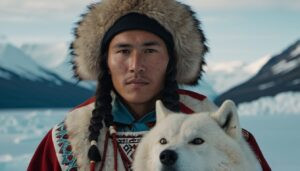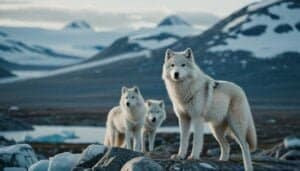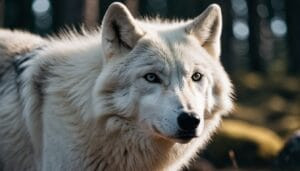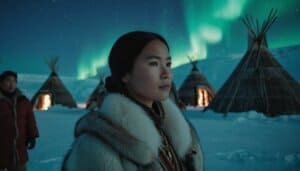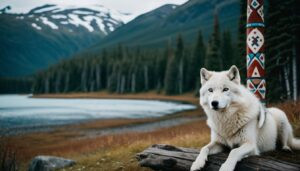Introduction
Arctic wolves are central figures in many indigenous Arctic stories, where their interactions with other animals like caribou, seals, and polar bears reveal rich cultural insights
These stories not only depict the natural behaviors and characteristics of Arctic wolves but also imbue them with symbolic meanings and cultural lessons
Throughout this article, we will explore the roles of Arctic wolves in these narratives, their interactions with various Arctic animals, and the broader cultural and spiritual significance they hold in indigenous folklore
Roles of Arctic Wolves in Indigenous Arctic Stories
Arctic wolves play diverse and significant roles in indigenous Arctic stories, often serving as symbols of survival, resilience, and interconnectedness with nature. These narratives reveal deep cultural meanings and values, illustrating how Arctic wolves are perceived and understood by native communities
Symbolic Meanings of Arctic Wolves
In many indigenous Arctic cultures, Arctic wolves are seen as powerful symbols of strength and adaptability. Their ability to thrive in the harsh Arctic environment is often highlighted in stories, emphasizing the importance of resilience and perseverance
For example, the Inuit people regard the Arctic wolf as a representation of family loyalty and cooperation. Wolves hunt in packs, and this teamwork is mirrored in the Inuit’s own social structures and survival strategies. In stories, the wolf’s tenacity and endurance serve as metaphors for overcoming adversity and enduring hardships
Additionally, Arctic wolves are frequently associated with spiritual significance. Some indigenous beliefs hold that wolves possess special powers or spiritual qualities
The Chukchi people of Siberia, for instance, view the Arctic wolf as a guardian spirit, protecting them from harm and guiding them through life’s challenges. These spiritual associations are often woven into tales where wolves act as protectors or guides, leading humans to safety or imparting wisdom
Interactions with Other Arctic Animals
Arctic wolves’ interactions with other Arctic animals in indigenous stories often reflect the complex web of relationships within the natural world. These interactions can range from cooperative alliances to competitive struggles, each carrying its own lessons and insights
In many narratives, Arctic wolves are depicted as cunning and intelligent hunters, skillfully preying on caribou, seals, and smaller mammals. These stories highlight the wolves’ role in maintaining ecological balance, as they help control prey populations and ensure the health of the ecosystem
For example, in some Inuit stories, the Arctic wolf’s hunt is portrayed with respect and reverence, acknowledging the necessity of predation in the cycle of life
Conversely, there are also tales of rivalry and conflict between Arctic wolves and other predators, such as polar bears. These stories often dramatize the competition for food and territory, reflecting the harsh realities of life in the Arctic
In one such story from the Kalaallit people of Greenland, a fierce battle between a wolf and a polar bear symbolizes the struggle for dominance and survival in the unforgiving Arctic landscape
In addition to these predatory and competitive interactions, indigenous stories sometimes depict cooperative relationships between Arctic wolves and other animals. For instance, some tales describe how wolves and ravens work together, with ravens leading wolves to potential prey in exchange for a share of the feast. This symbiotic relationship illustrates the interconnectedness of species and the mutual benefits of cooperation
Depiction of Arctic Wolves and Caribou Interactions
Arctic wolves and caribou share a complex relationship that is richly depicted in indigenous Arctic stories. These narratives explore themes of survival, predation, and the delicate balance within the Arctic ecosystem, providing insights into the natural behaviors and cultural significance of both animals
Story Examples Featuring Wolves and Caribou
One common theme in indigenous stories is the pursuit and hunt of caribou by Arctic wolves. These tales often highlight the wolves’ intelligence, cooperation, and hunting prowess
For instance, in a story from the Inuit people, a pack of wolves tracks a herd of caribou across the tundra, demonstrating their keen senses and strategic planning. The story illustrates not only the physical abilities of the wolves but also their social cohesion and teamwork, which are essential for successful hunting
Another example comes from the Gwich’in people, whose stories frequently feature the relationship between wolves and caribou. In one tale, a lone wolf musters the courage to confront a large caribou herd, showcasing bravery and determination. This narrative serves to teach the value of persistence and courage in the face of daunting challenges
In contrast, some stories depict the caribou as more than just prey. In these narratives, caribou are portrayed as noble and wise creatures, respected by the wolves and other animals. For instance, a Yupik story tells of a time when a wise caribou helps guide a lost wolf back to its pack, illustrating themes of mutual respect and the interconnectedness of all life forms in the Arctic
Cultural Lessons from These Interactions
The interactions between Arctic wolves and caribou in indigenous stories often carry profound cultural lessons. These narratives teach important values such as respect for nature, the importance of balance, and the necessity of sustainable practices
One significant lesson is the concept of balance within the ecosystem. Indigenous stories emphasize that both predators and prey have vital roles in maintaining ecological harmony
The relationship between wolves and caribou is a prime example of this balance, as wolves help control caribou populations, preventing overgrazing and ensuring the health of the tundra. This ecological balance is a central theme in many stories, underscoring the interconnectedness of all life in the Arctic
Additionally, these stories often highlight the need for respect and gratitude towards the animals that provide sustenance. For example, in Inuit culture, it is customary to thank the spirit of the caribou after a successful hunt, acknowledging the animal’s sacrifice. This practice is reflected in stories where wolves show reverence for the caribou they hunt, teaching the value of humility and respect for the natural world
Another lesson conveyed through these interactions is the importance of cooperation and community. The pack dynamics of wolves, with their emphasis on teamwork and social bonds, mirror the communal values of many indigenous Arctic societies
Stories featuring wolves and caribou often emphasize the strength that comes from working together, whether it’s a pack of wolves hunting in unison or a herd of caribou moving as one to avoid predators. These narratives reinforce the idea that collective effort and solidarity are crucial for survival in the harsh Arctic environment
Stories of Arctic Wolves and Polar Bears
Arctic wolves and polar bears, two apex predators of the Arctic, often feature prominently in indigenous stories. These tales explore themes of competition, cooperation, and survival, highlighting the dynamic and sometimes adversarial relationship between these formidable creatures
Cooperative and Competitive Behaviors
In many indigenous Arctic stories, the interactions between Arctic wolves and polar bears are depicted with a blend of awe and respect, emphasizing the balance of power and the natural order. These narratives often illustrate the competitive nature of their relationship, as both species vie for similar prey such as seals and other marine animals
One such story from the Inuit people tells of a fierce encounter between an Arctic wolf pack and a polar bear over a seal carcass. The tale emphasizes the strategic cunning of the wolves as they work together to outmaneuver the larger, stronger polar bear
This story serves to highlight the importance of intelligence and teamwork in overcoming physical disadvantages, a recurring theme in indigenous folklore
Conversely, there are also stories that depict moments of uneasy cooperation between these two predators. For instance, in a tale from the Chukchi people, a polar bear and an Arctic wolf find themselves trapped on a drifting ice floe
Forced to work together to survive, they form a temporary alliance, sharing their hunting skills and knowledge to catch fish. This story illustrates the potential for cooperation and mutual benefit, even among natural rivals, teaching the value of adaptability and collaboration in the face of adversity
Mythological Significance in Indigenous Tales
The mythological significance of Arctic wolves and polar bears in indigenous stories often transcends their physical interactions, imbuing them with symbolic meanings and spiritual connotations. In many cultures, these animals are revered as powerful spirits or totemic beings, representing different aspects of the natural world and human experience
For example, the Inuit mythology often portrays the polar bear, known as Nanuk, as a powerful and respected figure, embodying strength and endurance. In stories, Nanuk is sometimes depicted as a teacher or guide, helping humans to navigate the harsh Arctic environment
The Arctic wolf, on the other hand, is frequently seen as a symbol of intelligence, loyalty, and social cohesion. When these two animals appear together in stories, their interactions can symbolize the balance between physical power and mental acuity, as well as the complex dynamics of the natural world
In a legend from the Inupiat people, a great white wolf and a mighty polar bear are said to have been created by the spirits to maintain harmony in the Arctic. The wolf’s role is to keep the caribou populations in check, while the polar bear ensures that seals do not become too numerous. This tale underscores the belief in a divinely ordained balance in nature, with each animal playing a crucial part in the ecosystem’s health
Another story from the Sami people of northern Scandinavia tells of a shaman who transforms into a wolf to seek the guidance of a polar bear spirit
The bear teaches the shaman important lessons about strength and resilience, which he then brings back to his people. This narrative highlights the spiritual connection between humans and these powerful animals, as well as the transfer of wisdom and knowledge from the natural world to human society
Arctic Wolves’ Hunting Behaviors in Folklore
Arctic wolves are celebrated in indigenous Arctic stories for their keen hunting abilities and strategic prowess. These narratives not only provide insights into the wolves’ behaviors and techniques but also reflect the cultural values and survival skills of the communities that tell these stories
Hunting Techniques and Strategies
Indigenous Arctic stories often detail the sophisticated hunting techniques and strategies employed by Arctic wolves. These narratives highlight the wolves’ intelligence, patience, and cooperation, which are essential for their survival in the harsh Arctic environment
One common theme in these stories is the wolves’ use of teamwork to take down larger prey. For example, an Inuit tale describes how a pack of wolves surrounds a herd of caribou, with some wolves driving the caribou towards others lying in wait
This coordinated effort ensures a successful hunt and demonstrates the importance of social cohesion and collective action. The story underscores how working together can overcome individual limitations, a valuable lesson for the community
Another example is found in the tales of the Sami people, who recount how Arctic wolves use the terrain to their advantage. In these stories, wolves are depicted as luring prey into difficult-to-navigate areas, such as deep snow or narrow gorges, where the prey’s mobility is hindered, making it easier for the wolves to capture them. This strategic use of the environment showcases the wolves’ adaptability and cleverness, qualities that are admired and respected in the Sami culture
Additionally, indigenous stories often emphasize the wolves’ patience and endurance during the hunt. In a narrative from the Chukchi people, a lone wolf follows a weakened caribou for days, waiting for the right moment to strike. This tale highlights the wolf’s persistence and determination, traits that are highly valued in Chukchi society, where long, arduous hunts are a common part of life
Impact on Ecosystem as Depicted in Stories
The role of Arctic wolves in maintaining the ecological balance is a recurring theme in indigenous Arctic folklore. These stories illustrate how wolves help regulate prey populations, ensuring the health and sustainability of the ecosystem
For instance, in a story from the Gwich’in people, the presence of wolves is credited with keeping the caribou population in check, preventing overgrazing and the subsequent degradation of the tundra
The narrative explains that without wolves, the caribou would multiply unchecked, leading to the destruction of the vegetation and the eventual decline of both species. This story highlights the concept of the “circle of life,” where every species has a role in maintaining ecological harmony
Similarly, the Inuit have stories that depict the wolves’ role in controlling the populations of smaller animals, such as lemmings and hares. By preying on these animals, wolves help to prevent outbreaks of disease and overpopulation, which could otherwise have detrimental effects on the ecosystem. These tales reflect a deep understanding of the interdependence of species and the importance of predators in maintaining ecological balance
In addition to their ecological impact, Arctic wolves are also portrayed as teachers in indigenous stories, imparting important lessons about respect for nature and sustainable practices
For example, some Inuit tales describe how the spirit of the wolf teaches hunters to only take what they need and to show gratitude for the animals they hunt. This respectful approach to hunting is central to Inuit culture and is reinforced through stories that emphasize the wolves’ role as guardians of the natural world
Conclusion
Indigenous Arctic stories offer a rich tapestry of insights into the interactions between Arctic wolves and other animals, reflecting the cultural, spiritual, and ecological values of native Arctic communities
These narratives depict Arctic wolves as symbols of resilience, intelligence, and cooperation, illustrating their complex relationships with other creatures such as caribou, polar bears, and seals
Through detailed depictions of hunting strategies, competitive and cooperative behaviors, and symbolic meanings, these stories emphasize the importance of balance and respect for nature. The interactions between Arctic wolves and caribou teach lessons about perseverance and the necessity of ecological equilibrium
Tales of wolves and polar bears highlight the dynamics of competition and the potential for cooperation even among rivals. Meanwhile, the wolves’ hunting behaviors, as recounted in folklore, underscore their role in maintaining the health of the ecosystem and impart valuable lessons on sustainable practices
By examining these indigenous narratives, we gain a deeper appreciation for the cultural heritage and ecological wisdom of Arctic peoples. These stories not only preserve traditional knowledge but also offer timeless lessons about the interconnectedness of all life and the importance of living in harmony with the natural world
Understanding these tales allows us to appreciate the profound relationship between humans and the environment, as seen through the lens of indigenous Arctic storytelling


